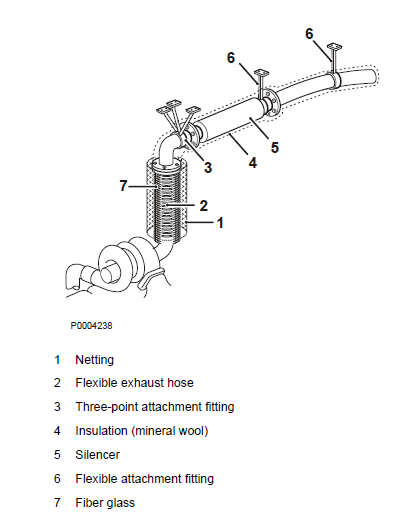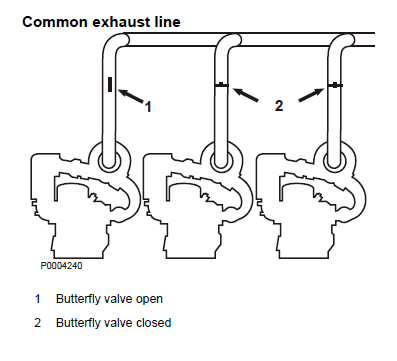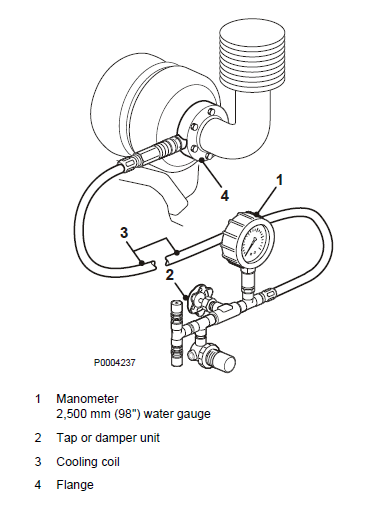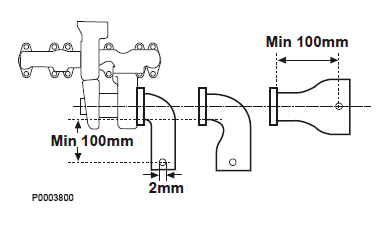Dry Exhaust Line
Silencer
In general there are two types of silencer: absorbing and reactive.
Absorbing silencers
These silencers work according to the principal of absorbing sound with the aid of an absorbent lining inside the silencer. They usually provide silencing over a broad frequency range. They are generally of straight-through construction and only offer a marginally higher back pressure than a straight pipe of the same length.
Expansion silencers (reactive)
These silencers work according to the principal of reflecting sound and thereby retaining it inside the silencer. The silencer has internal baffle plates that divide it up into sections that can be adjusted individually to a given frequency. A reactive silencer creates a relatively high back pressure owing to the meandering route of the gas flow, i.e. past the baffles that redirect the flow. Volvo Penta HD silencers combine reactive and absorbing silencing. Silencer location Reactive silencers are located as close to the exhaust manifold as possible (to impede sound from the manifold) or at the end of the system. The absorption unit is generally located in line directly after the reactive unit. There must only be a short end pipe (≈ 1 m) after the silencer if it is installed at the end of the exhaust line. Insulation of long exhaust lines affects exhaust back pressure and exhaust pipe diameter must therefore be increased.
Exhaust System

General points for consideration
The exhaust system must be planned from the beginning of the installation.
The main objectives are to:
A ensure that back pressure in entire system is below the max limit set by the engine manufacturer.
B reduce strain on the manifold and turbocharger by supporting the system.
C provide space in the correct directions for heat expansion and contraction.
D provide flexibility if the engine is fitted with vibration dampening mounts.
E reduce exhaust noise. The illustration on the right shows a typical installation.
Multiple Exhaust Outlets

IMPORTANT!
Exhaust gases from multi-engine installations may not be led together in a common system, as this can be very dangerous and cause engine damage. The reason for this is that if one engine is at rest while the other is running, exhaust gases, condensate and soot will be forced into the resting engine's exhaust system and on into the cylinders, which may cause corrosion. If a good quality butterfly valve is installed in every exhaust line close to the duct, common exhaust lines
may sometimes be approved. Use the following formula for calculating the total diameter of the common exhaust pipe:
DTOTAL = D x K
D = exhaust pipe diameter for one engine.
K = factor (refer to the table).
Number of engines | Factor K |
2 3 4 5 6 | 1.32 1.55 1.74 1.90 2.05 |
Factor K = 5√(number of engines)2
Back Pressure
The exhaust system will give a certain resistance to exhaust gas flow. This resistance (back pressure) must be kept within given limits.

Excessive back pressure causes:
- Loss of power
- Poor fuel economy
- High exhaust temperature
Such conditions will cause overheating and excessive engine smoke, and will reduce valve and turbocharger service life. Maximum permissible engine pressure values for Volvo Penta engines are specified in the Sales Support Tool, Partner Network.
A manometer is used to measure exhaust back pressure at maximum rated power.

It may be difficult to use a flange in many installations because of a lack of space. If a hole must be drilled specially for the pressure test it is important that the hole is small max Ø 2 mm (0.08") and located on a straight pipe section. Make sure the hole is free from swarf. The distance from the hole to pipe bends and tapered sections must be at least 100 mm (4").
Calculation of Back Pressure
Calculation of back pressure for HD silencers For the purpose of calculating back pressure on Volvo Penta silencers exhaust flows and temperatures are specified in an Excel-based system in the Sales Support Tool, Partner Network.
NOTICE! The application for calculating exhaust system back pressure is based on a worst case, namely an insulated exhaust pipe at its full length. This means that the calculated exhaust back pressure is somewhat excessive for uninsulated exhaust systems. The calculation application is also based on system pipe bends having a radius of 2.5 times the pipe diameter. Silencer back pressure used in the application is only applicable to Nelson-Burgess DDA type silencers. These silencers are described with their diameters in inches followed by HD in the Industrial Sales Guide.
Calculating exhaust system back pressure | ||
Exhaust flow m/min | 99 | 5940.00 m3/h |
Exhaust temp., °C | 565 | 0.42 kg/m3 |
Pipe diameter | 7" | 177.80 mm |
Pipe length, meters | 10 | 0.84 kPa |
Number of 45° bends | 2 | 0.06 kPa |
Number of 90° bends | 3 | 0.19 kPa |
Exhaust speed | 66.46 m/s | |
Power loss, exhaust outlet | 0.93 kPa | |
Total back pressure, exhaust pipe | 2.03 kPa | |
DDA - Exhaust silencer, size. | 7" | |
Back pressure, silencer | 2.98 kPa | |
Total back pressure, exhaust system | 5.02 kPa | |
Comments: TAD1631GE; Reserve power at 1,500 rpm. | ||
Installation
Flexible connection pipes
The exhaust pipe is isolated from the engine with flexible connection pipes. The flexible connection pipes are located close to the engine exhaust outlet and have three functions:
1 Isolating vibrations and exhaust pipe weight from the engine.
2 Compensating exhaust pipe expansion.
3 Compensating sideways motion when the engine starts or stops when the engine is attached to vibration dampening mounts.
The flexible pipe is able to absorb small radial movements, but no twisting or axial movements.
The flexible unit can be installed in different positions, but should preferably be installed vertically and not be bent.
In the calculations, consideration must be given to exhaust pipe heat expansion to avoid excessive strain on the supporting structure.
For every temperature increase of 100 °C (212 °F) one meter of steel pipe will expand around 1.2 mm (0.047"). It is therefore important to locate the holders such that the pipe is able to expand away from the engine to avoid straining and twisting connected equipment. Furthermore,
equipment must removable without additional support.
Long pipes are divided into sections using expansion joints. Each section is fixed at one end and is able to expand at the other.
Condensate drainage
Any rainwater or condensate that gets into the engine can cause great damage. Long exhaust lines must therefore be equipped with water drainage located as close to the engine as possible.
For More Volvo Engine workshop information, please visit
Volvo Diesel Engine Filter Categories
Copyright © Guangxi Dingbo Generator Set Manufacturing Co., Ltd. All Rights Reserved | Sitemap
Update cookies preferences